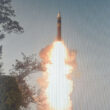What’s possible: Hypersonic harm reduction
By Tong Zhao, August 6, 2015
A central paradox of the hypersonic arms competition now under way is that the United States—the competition's initiator and frontrunner—has so far secured no military advantage from hypersonic technology but already perceives an emerging threat from it. Indeed, a US House of Representatives committee report on the 2015 defense authorization bill expresses concern that "China and other competitor nations pose an increasing challenge to the United States' technology edge in … hypersonic weapons." The report requires the Pentagon to "explain how the Department of Defense intends to develop and deploy a defensive capability to counter this emerging threat." So hypersonic competition, like other competitions in military technology, is quickly becoming a self-reinforcing spiral. Nations interested in hypersonic missiles, convinced that faster weapons are the weapons of the future, embrace hypersonics without thinking through the advantages and disadvantages—and especially without thinking through other nations' reactions.
My roundtable colleague Mark Gubrud, with his proposal for a hypersonic missile testing ban, is seeking solutions to hypersonic competition. I applaud him for it. And I share his general skepticism about the military value of hypersonic missiles. Where we disagree is on a test ban's feasibility.
Gubrud proposes that the movement toward a test ban begin with unilateral testing moratoria. But this idea will not go far unless the United States agrees to engage—and the United States has shown little interest in arms control commitments that cannot be effectively verified. A prominent example is the Treaty on Prevention of the Placement of Weapons in Outer Space, an arms control measure proposed by Russia and China in 2008 but repeatedly rejected by Washington, in large measure because of verification concerns. A hypersonic test ban, despite what Gubrud believes, would not be easy at all to verify—for the technical reasons that I covered in Round Two.
So what is a feasible response to the problems posed by hypersonics? One way forward, though it is far from an ideal path, is for nations to refrain on a unilateral basis from adopting destabilizing policies regarding the deployment and use of hypersonic technology. In Round One I offered some specific ideas in this vein. First, nations could pledge not to use hypersonic missiles against nuclear targets. Second, they could renounce strategies—such as preemptive hypersonic strikes against command, control, and communication centers—that could intensify the "fog of war" and lead to inadvertent escalations.
Meanwhile, my roundtable colleague Rajaram Nagappa has called for all countries to refrain from arming hypersonic missiles with nuclear warheads. Nagappa's proposal, by maintaining a clear distinction between nuclear and conventional delivery systems, would contribute to stability. But whether his proposal can be implemented will depend to a great extent on Russian and Chinese threat perceptions regarding future US missile defense capabilities. That is, Moscow and Beijing are pursuing hypersonic weapons primarily as a hedge against future US missile defenses, which might undermine Russia and China's ability to deliver their nuclear deterrents with ballistic missiles. Gubrud suggests that hypersonic missiles themselves would be relatively easy to defend against—but I am not so sure. In particular, it would be extremely challenging from a technical perspective to build an "area defense" (as opposed to a more manageable "point defense") against hypersonic missiles. At this point in the development of hypersonics, technical uncertainty makes it impossible to draw definite conclusions about the missiles' effectiveness and their vulnerability to defensive measures.
Building consensus in favor of a test ban will be very difficult. A more practical approach is for states to ensure that hypersonic missiles, if they are to be built and deployed, are included in nuclear arms control discussions and are accounted for in arrangements limiting or reducing strategic arms.
Topics: Nuclear Weapons, Technology and Security
Share: [addthis tool="addthis_inline_share_toolbox"]














